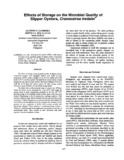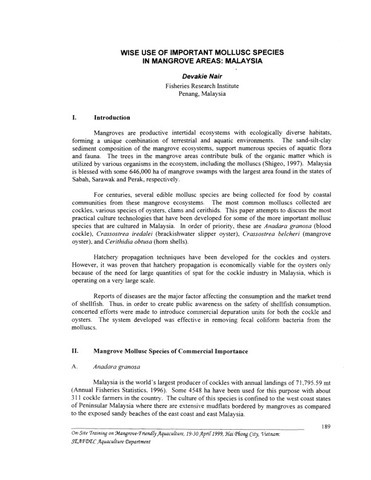Effects of storage on the microbial quality of slipper oysters, Crassostrea iredalei
- Global styles
- MLA
- Vancouver
- Elsevier - Harvard
- APA
- Help

View/
Date
1986Page views
3,614ASFA keyword
AGROVOC keyword
Taxonomic term
Metadata
Show full item record
Share
Abstract
The effects of storage on the microbial quality of slipper oysters, Crassostrea iredalei, were examined. Oysters were stored at room temperature (24°C), under a blanket of ice (3-4 C), chilled (4-C) and frozen (-25°C) until they spoiled. The shelf life of oysters stored at room temperature was only two days. Oysters held under a blanket of ice had a shelf life of 14 days and chilled oysters, 22 days. Frozen oysters remained in good condition over the 64 day storage period.
The initial total aerobic bacterial count of oysters was 105cfu/g. Counts for frozen oysters decreased by 1 log (104) while counts for oysters stored at other temperatures increased by 2-4 log (107-109). Bacterial typing of 50 randomly-picked colonies made every four days showed Pseudomonas to be the predominant spoilage organism. Total and fecal coliform counts did not increase even for oysters held at room temperature. Typical Staphylococcus aureaus colonies were isolated but were shown to be non-pathogenic by the coagulase test. Analyses for the presence of other organisms of public health concern revealed that Salmonella, Shigella, Vibrio cholerae, V. parahaemolyticus, Lactose + Vibrios (V. vulnificus) and fecal streptococci were present in very low or undetectable levels. Thus, hazards or risks associated with these organisms may be considered minimal.
Type
Conference paperCollections
- Conference Proceedings [298]
Related items
Showing items related by title, author, creator and subject.
-
A method of culturing/ growing high-quality edible oysters (Crassostrea spp. and Magallana bilineata)
Lebata-Ramos, Ma. Junemie Hazel; Southeast Asian Fisheries Development Center/Aquaculture Department (Intellectual Property Office of the Philippines, 2024-11-18)This utility model discloses a process of culturing/ growing high-quality edible oysters (Crassostrea spp. and Magallana bilineata) comprising the steps: selecting grow-out culture sites, deploying substrates ... -
Wise use of important mollusc species in mangrove areas: Malaysia
Nair, Devakie (Aquaculture Department, Southeast Asian Fisheries Development Center, 2000)For centuries, several edible mollusc species are being collected for food by coastal communities from these mangrove ecosystems. The most common molluscs collected are cockles, various species of oysters, clams and ... -
Socio-economics of oyster and mussel farming in Western Visayas, Philippines
Samonte, Giselle P. B.; Siar, Susana V.; Ortega, Rolando S.; Espada, Larni T. (Asian Fisheries Society, 1994)Among the economically important bivalves, the slipper oyster (Crassostrea iredalei) and green mussel (Perna viridis) are predominantly being farmed in the Philippines. Oyster and mussel farms in the Western Visayas region ...





